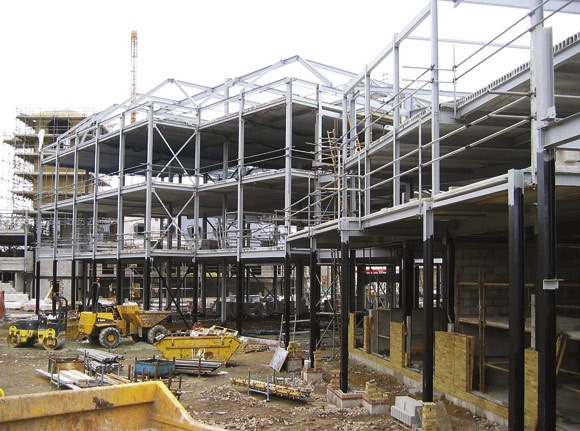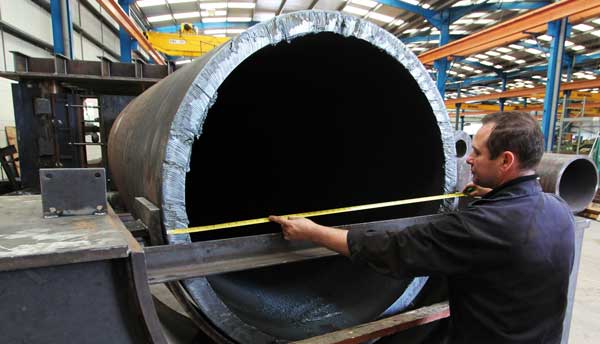Technical
High grade steel: the new standard for cost effectiveness
High grade steel is becoming much more popular. Richard Barrett, Chairman of BCSA’s Process and Technical Committee, explains why modern designers increasingly prefer high grade over standard grade.
Twenty years ago the vast majority of structural steelwork was designed in “standard” grade 275 (or grade 43 as it was then known). It was quite unusual on everyday structures to come across “high” grade 355 steel (old grade 50). Today high grade steel is widely used; for example, last year in the author’s own business the majority of steel used was 355 grade. What has changed over this period? Why is high grade steel becoming the grade of choice for many designers?
Steel grades
S355 grade steel is not new, and it’s not particularly high grade either! It is colloquially referred to as high grade, to differentiate it from standard grade 275. In reality there are many much higher grades available, but these are not seen on day-to-day structures. So for simplicity I will continue with the “high” grade colloquialism throughout this article, although the purist would refer to S355 grade each time.
The grade refers to the yield strength of the steel – the higher the grade, the higher the yield strength. The various grades are set down in BS EN 10025:2004. Steelmakers can increase the yield strength of their steel through various means – adjusting the chemical composition, using heat treatment and through manufacturing processes such as cold working. The chemical composition of high grade steel will normally differ from standard grade through the addition of either carbon or other elements. Adding carbon increases strength but also reduces the steel’s toughness, so it is common to also “alloy” the content by adding trace metals such as manganese, chromium, molybdenum, nickel or copper.
There are various subgrades or so-called “qualities” available with each grade category. In particular, special subgrades will be required for low temperature applications such as external steelwork or exposed cold store steel, where the normal subgrade would not be suitable due to the reduced toughness of steel at lower temperatures.
The steel producer provides a Test Certificate or Inspection Document for the steel which shows the grade, subgrade, and the chemical analysis of the batch, together with results of mechanical tests. These should show that the yield strength is above the minimum required in the product standard for the particular grade.
Fabrication aspects
Whereas with true high grade steel (460 and upwards), welding needs to be carried out with special care, using techniques such as pre-heating this is rarely the case with Grade 355 steel. Fittings material is normally standard grade, being easier to source for items such as flats and angles. There is a danger however, that the use of high grade steel will result in more complex connections, particularly if inappropriately small beams size are selected. The experienced designer will avoid this problem by carefully considering the practicality of the joint when selecting the steel size, to ensure it is possible to form a connection without the need for excessive welding or stiffening.
Commercial factors
One of the major changes over recent years has been the increasing availability of high grade steels. Medium and large sizes of universal beams and columns are now widely available through steel stockholders, as are the Corus Hybox range of hollow sections. As these sizes have become more popular, stocks have increased, creating a virtuous circle of usage and availability. Additionally, the premium charged by steelmakers for high grade over standard grade has been progressively reduced, for some sizes disappearing altogether. High grade now offers a very attractive cost-to-strength ratio when compared with standard grade.
Availability is still an issue for small sections, and is likely to stay that way. This is because there is little or nothing to be gained by using high grade steel for beam sizes below 406mm, and therefore usage is small. Specifying high grade in these small sizes is wholly uneconomical and should be avoided if possible. The same applies with flats, angles and channels.
Design issues
In modern designs, high grade steel is essential to optimise the economy of the steel frame. Many types of buildings will benefit from the use of high grade steel – in single storey structures for large span portal frames, in multi-storey structures for the columns, and in composite construction for the beams as well. The photographs show examples of the use of high grade steel by the author’s company, Barrett Steel Buildings. These building types are the mainstream of the industry and represent the areas where most steel is used – hence the rapidly rising use of high grade steel. Designs for this type of structure incorporating high grade steel will give very economical solutions.
Owing to classification of sections for design purposes, certain sizes are not suitable for plastic action. In standard grade there are just five such sizes (all are UCs). With high grade there are more, seven beams and nine columns. This only affects a few serial sizes, normally the lightest section in the size (such as 356x171x45UB or 406x178x54UB). Consequently these sections are somewhat restricted in suitability for high grade use. Additionally high grade will probably not benefit designs where fatigue loading is present, or when buckling action is the critical case.
It is normal to use standard grade material for connections. Therefore connection design, including weld strength, will be governed by the strength of the connection material rather than the strength of the high grade main members.
Future trends and conclusions
Increasing availability of high grade steel, coupled with diminishing premium costs, means that it offers a very attractive cost-to-strength ratio. Consequently use is increasing rapidly, and this is improving the overall competitiveness of steel framed solutions. In the long term I believe it is likely that Grade 355 will become the standard grade for most beam, column and hollow section sizes, with Grade 275 only being retained for small beams and fittings materials.












